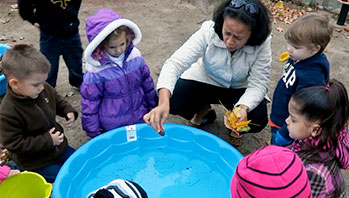- camera or video camera
- children’s bean and grass plants
- plant
MA Standards
English Language Arts/Language/L.PK.MA.6: Use words and phrases acquired through conversations, listening to books read aloud, activities, and play.
English Language Arts/Writing/W.PK.MA.6: Recognize that digital tools (e.g., computers, cell phones, cameras, and other devices) are used for communication and, with support and guidance, use them to convey messages in pictures and/or words.
Head Start Outcomes
Logic and Reasoning/Reasoning and Problem Solving: Classifies, compares, and contrasts objects, events, and experiences.
Science Knowledge/Scientific Skills and Method: Observes and discusses common properties, differences, and comparisons among objects.
PreK Learning Guidelines:
English Language Arts/Language 2: Participate actively in discussions, listen to the ideas of others, and ask and answer relevant questions.
Science and Technology/Inquiry Skills 4: Record observations and share ideas through simple forms of representation such as drawings.
Explore Together (outdoors): Indoor and Outdoor Plants

© Commonwealth of Massachusetts, Department of Early Education and Care. All rights reserved.
STEM Key Concepts: There are many different types of plants; Plants grow in many places; Plants have different parts: roots, stems, and leaves
ELA Focus Skills: Compare and Contrast, Listening and Speaking, Vocabulary
Safety Tips:
- Be aware of and check for poison ivy and poison sumac before gathering children in a designated area.
- Remind children to wash their hands before and after the activity.
- Remind children not to eat ANY plants or touch any plants without asking an adult.
- Take children’s allergies into account before going outside.
Tell children they are going to explore indoor and outdoor plants together. Explain that you will bring one of the bean plants and one of the grass plants outdoors so children can compare the indoor plants and the outdoor plants.
Take children outdoors so they can make connections between the indoor and outdoor plants and continue to compare the parts of plants. Have children work in two groups—one with the bean plant and one with the grass plant. After ten minutes, have them switch.
- Bean plant group: Have children find plants growing on the ground that have leaves that are similar to the leaves on their bean plant. Encourage children to talk with one another about how the leaves are similar.
- Grass plant group: Let children compare their grass plant with the grass that is growing outdoors. Have them talk with each other about how the grasses are similar and different. Encourage children to think about and discuss whether all the grasses growing outdoors look the same or whether there are different kinds of grasses.
Help children take photographs of the plants they find outdoors. Once inside, invite children to draw pictures of the plants they observed, showing similarities and/or differences between indoor and outdoor plants.
Reflect and Share
Invite children to share their observations with the group. Ask,
- What was similar about the bean plants and the plant you found outdoors? What was different?
- How was the grass we are growing different from the grass outdoors? How was it the same?
Encourage children to think about how plants grow in many different places.
Adaptation: For groups with very young children who may wander and be unable to successfully search for similar leaves, you may want to bring children to an area around the school where there are many different plants and examples of plant leaves. Have children collect some samples. Bring the samples back to the room or to an outdoor table and display the leaves. Have children compare and contrast the leaves on their own plants with those they found outdoors.
